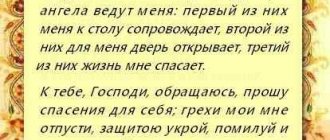When a child is born, every Orthodox mother wonders when after giving birth she can go to church. There are several rituals that must be performed on a newborn baby and his mother, among which the most important is baptism. The Orthodox Church has a number of restrictions on this matter. For some time after giving birth, a woman experiences postpartum bleeding. According to the majority of representatives of the Orthodox community, entering a temple, performing church rituals, or touching shrines during this time of the cycle and the postpartum period is prohibited. However, not all church ministers agree with him.
According to some clergy, prohibitions on visiting church are relics of the past; a woman can come to church at any time. Meanwhile, a visit to the temple by a mother and her child is necessary. The priest must read certain prayers over the woman and perform the ceremony of churching and baptism of the baby. These actions are mandatory for Orthodox people. When can you visit the temple, what restrictions may there be and what rituals must be performed? Details can be found by reading further.
“There is no need to baptize infants: you can come to faith only consciously”
This position exists among some Protestant movements, but it contradicts the Orthodox religious tradition. Orthodox Christians baptize children according to the faith of their parents, introducing them to God's grace immediately after birth.
An unbaptized person cannot participate in the Sacraments of the church, Holy Communion is not available to him, and he cannot be prayed for in general church prayer. For church-going Orthodox parents, this approach is unacceptable.
Baptism is not only about alienation from sins. The baby, of course, has not yet committed a single sin, but he still needs baptism: this Sacrament leads to communion with God. After all, Christ himself said:
Do not hinder children from coming to Me, for to such is the kingdom of God. (Mark 10:14)
Disinfection wipes can be made at home: an effective recipe
More comfortable in crowds: Emotional safety and anxiety from close friendships.
Elizabeth Taylor was married eight times. The reason was her parents
In the lives of the first Christians there are references to baptism by entire families, and it would be strange to think that there were no small children in these families.
Baptism time
In Orthodox practice, there are three most desirable dates for the baptism of a child: on the third, eighth or fortieth day after birth. All parents tried to do this as early as possible, that is, three days after birth. If the newborn was very weak (they said, “not a long-term survivor”), then they could send for a priest almost immediately after the baby was born.
If the child looked strong and vital, the ceremony could be postponed to the third or eighth day. Such a delay was necessary so that the parents had time to prepare for the sacrament and be sure to find godparents for their child. Only as a last resort was the child baptized on the fortieth day, which in the Orthodox tradition was chosen by analogy with the fortieth day after death, when the soul of the deceased goes to the “heights of heaven” and appears before the Court of God.
"Anyone can become a godfather"
Unfortunately, those who approach the baptism of children thoughtlessly often choose their closest friends as godparents: as a rule, to please them, to “adopt them into the family,” or simply for the sake of having someone present at the ceremony.
However, this is a fundamentally wrong approach, since godparents have the important responsibility of raising a child in the Christian faith. Therefore, you need to approach the issue responsibly and choose as godparents not those who are “nominally” baptized, but those who are ready to take the trouble to tell the child about God and help the parents raise him according to Christian canons.
Moreover, godparents cannot become godparents, atheists or mentally ill people, and godparents cannot be husband and wife.
What is the ritual?
Before the sacrament, the priest usually talks with the parents and godparents of the child. If the person being baptized is an adult, then the conversation is conducted with him.
On the scheduled day, it is better to arrive at the church earlier than the appointed time in order to tune in to an important action, familiarize yourself with the surroundings and not be forced to wait for the clergyman. At the signal, the recipients bring the child into the temple. If two godparents are chosen, then the girl is in the arms of the godfather, and the boy is in the arms of the godmother. Before the ceremony, the child must be undressed and wrapped in a diaper.
The ceremony takes place next to the font, where the godparents read the “Creed” and renounce the devil, holding the person being baptized in their arms. The priest then lowers the child into the font three times. Immediately following baptism is a rite called confirmation . The priest applies myrrh oil in cross-shaped movements on the forehead, eyes, nose, mouth, ears, chest, arms and legs.
Let's get acquainted with the secrets of caring for a newborn boy. Useful tips and detailed instructions for parents.
Find out what the temperature of a newborn should be https://mamavika.com/detsk-zdorov/uhod-za-malyishom/kakaya-temperatura-dolzhna-byit-u-novorozhdennogo.html.
Then the child is taken in by his godfather, who must be of the same sex as the baby. The recipient wraps the child in kryzhma, and the clergyman puts a cross on the baptized person.
The priest cuts off small strands of the child's hair in the shape of a cross. The tonsure symbolizes submission to the Lord and the sacrifice made by the child for the gift of the Almighty - eternal life.
When baptism and confirmation are over, the priest walks around the font with the child three times. The priest brings the boy into the altar, and the girl brings him to the icon of the Mother of God.
After all the actions have been completed, the mother takes the child and leaves the temple with him. The duration of the ceremony is usually from one to two hours. If several children are baptized at the same time, the time may increase.
Baptism is a great sacrament and, whenever it takes place, it must be taken very seriously and prepared thoroughly and thoughtfully. After all, after the ceremony, a person is reunited with the church and receives the right to a second, eternal life.
“You can cross a child if something bad happens to him”
Baptism, like birth, occurs once in a person’s life. It is impossible to “cross yourself”: consciously committing such an act is considered a great sin. Moreover, one should not succumb to occult superstitions, which involve repeated baptism “from damage and the evil eye.” According to church teaching, participation in any magical rituals is an insult to the Christian faith.
Paris Hilton doesn't look like herself in Lanvin advertising campaign
Baskets with juicy salad: ingenious snacks without financial burden
Megaphone parenting brings negative results: why yelling is ineffective
Even if baptized in another generally recognized confession (for example, Catholics), you cannot undergo the Sacrament again.
Repeated baptism is allowed in the only case: when it is unknown whether the fact of baptism had occurred in a person’s life earlier (for example, in the USSR this was very common during the period of persecution of Christians, when children were baptized secretly). In this case, before the Sacrament, you need to talk with the priest: usually the phrase “Unless baptized” is added to the rite of baptism.
When they gave a name
The first - generic - name was given to the child immediately after birth. This was the privilege of the parents. Sometimes it happened that the midwife who delivered the baby could give birth to a weak baby. This custom was especially common in small villages, where there was only one priest, and even he could be busy. The midwife named the baby and immediately dipped him in holy water, which symbolized baptism.
The child received the second - church - name already at the time of the baptismal ceremony in the church. He was chosen by the godparents and the priest, in accordance with the church calendar in this matter. Parents had little influence on the choice of name. Usually they accepted what the priest offered. All these traditions have been preserved in Russian Orthodoxy to this day.
“After baptism, it is necessary to dress the child in new clothes.”
This superstition is also mystical in nature; in Orthodoxy it is absolutely not important what a person wears.
Indeed, according to pious tradition, after the font the child is dressed in a white baptismal shirt, which is a symbol of new birth in Christ. However, nothing bad will happen if the baby is changed immediately after the ceremony.
Scientists from Pushchin have created super-sweet tomatoes and potatoes that do not spoil
What Researchers Know About Astral Projection: Is Leaving the Body Real?
“Makeup artist in a hijab”: the most popular bloggers in the East
Traditions of infant baptism
This feature of the national character greatly affected many aspects of the life of the inhabitants of Ancient Rus'. Russian believers, like other Slavs, were born, lived and left this land “deeply Christians.” Since an unbaptized person a priori cannot claim a place in the kingdom of heaven, any Russian was simply obliged to undergo the rite of baptism.
This also applied to newborn babies, who obviously cannot have any sins and do not deserve fiery Gehenna. In view of the sad state of medicine at that time and the high infant mortality rate, parents sought to baptize their child as early as possible. This is fundamentally different from Catholic views, which allow a person to be baptized at a conscious adult age. Many Catholics believe that a person should consciously come to faith and only after that be baptized.
The inhabitants of Ancient Rus' could not afford such liberalism. The primary task of every father and mother was to provide their child with a heavenly life in the next world in the event of his death. The death of an unbaptized baby could bring disaster not only to himself, but also to his parents. According to pagan memory, Russians believed that all unbaptized children turn into mermaids after death and come home to their relatives at night.
Preparation for the ceremony
This ritual was and is considered a special holiday for any believing family. After all, here the purification of the soul and body occurs simultaneously. Therefore, parents should approach the choice of a godfather with special care, because until the child begins to independently worship God, it will be the godparents who will do this for him.
Therefore, they must be exclusively Orthodox and not have intimate relationships with each other. Therefore, spouses or those who are going to become godparents in one couple cannot be godparents of one child. Sometimes church ministers can deviate from the rules and allow a person of a different faith to become a godfather if his parents ask for him and he is a sincere good person.
It is not necessary that there must be two godparents. One person is enough, for a girl’s godmother, for a boy’s godfather.
The responsibilities of godparents also include:
- Pray for your “child”, and after baptism the baby becomes one, on every holiday and every day before going to bed;
- Introduce your ward to the Bible and give him communion;
- From time to time, godparents must remove the “burden of motherhood” from the birth mother and take upon themselves the upbringing of the child.
Also, before the christening, the named parents must undergo a so-called conversation. But as practice shows, modern people mostly neglect this, citing lack of time. But this is something like a test for the title of godfather. Previously, the church did not allow such people to receive the sacrament, believing that they had not yet “grown up” to it.
Moreover, according to existing church rules, future godparents can have this conversation in any church. There, after this, they are required to give a certificate about this and on the day of christening they will simply show it to the priest. It is also highly desirable that the godparents know the prayer of the Creed - it is read three times by the holy father during the ceremony, and maybe he can ask the godparents about the same.
The day before the christening, the godparents should pray. It is also recommended that they confess the day before. It wouldn't hurt to fast. And abstain from sexual intercourse the night before baptism.
During the ceremony itself, godparents must have Orthodox crosses on their necks. After all, it is a priori assumed that they themselves are baptized.
What you need to purchase for the ceremony
According to tradition, the godmother acquires:
- Kryzhma is a special diaper;
- A shirt and if a girl is being baptized, then also a hat.
The godfather must buy a cross. It must be silver, since only this metal is classified as pure according to church rules. And gold, according to the same rules, is the metal of the devil. The following words must be engraved on the cross: “save and preserve.”
It is not recommended to wear clothes in which the baby was baptized and the kryzhma should not be washed. They are considered illuminated things and capable of helping a child in difficult situations. For example, in case of illness, it is enough to cover it with kryzhma and the illness should recede. Don’t forget to also pray while doing this. The mother must keep everything and pass it on to the child after he becomes an adult.
What to wear for adults
Visiting church requires a certain dress code, and not only for this procedure. For men, clothing in discreet colors is recommended. Pants and shirt. Definitely with long sleeves. Most priests react extremely negatively to short sleeves and T-shirts. Especially in the provinces.
If a man has tattoos, they must be hidden. Especially those that have a negative meaning and are not acceptable in the church.
For women, the requirements are more stringent:
- Her head must be covered with a scarf. No other headwear is permitted. So, dear ladies, think about your hairstyle in advance;
- No trousers, just a dress or skirt at least to the knees. Better yet, lower;
- No open shoulders and no neckline that exposes the breasts for everyone to see;
- In addition, no high heels or clothes with bright patterns are allowed. Wearing pendants in the form of skulls and no collars with spikes is not allowed in church. Everything must be strict and orderly. Remember that you don’t go to someone else’s monastery with your own rules. Therefore, leave all your demands regarding “freedom of speech and views” at home.
What is this Sacrament?
Baptism is one of the most ancient seven Sacraments of the Russian Orthodox Church, meaning the birth of a person for God, birth into a new Eternal life.
This Sacrament goes back to the Old Testament custom of circumcising Jewish babies on the 8th day of life, which made them members of the community and made it possible to begin the Passover meal. In the Old Testament, there was a custom for purification to perform a ritual immersion in water - a mikveh.
The baptism performed by John the Baptist filled this rite with a new meaning - it was repentance of sins.
And only the Baptism of the New Testament became the only way to unite a person with God, liberate him from original sin and gave the Christian a chance to enter the Kingdom of God. This is what Christ himself said: “... truly I say to you, unless one is born of water and the Spirit, he cannot enter the kingdom of God (John 3:5).










